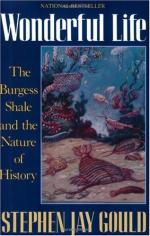
|
| Name: _________________________ | Period: ___________________ |
This test consists of 15 multiple choice questions and 5 short answer questions.
Multiple Choice Questions
1. What did the dissenter believe should happen to Aysehaia?
(a) It should be retained in a known class.
(b) It should spread to the lower classes.
(c) It should jump two classes.
(d) It should not exist.
2. When did prokaryotic cells exist?
(a) At 3.7 billion years.
(b) At 6.7 billion years.
(c) At 3.5 billion years.
(d) At 3.5 million years.
3. What type of example is Aysehaia?
(a) A lesser example.
(b) A omnipresent example.
(c) A further example.
(d) A godsend example.
4. What did Whittington next begin work on?
(a) Naraoia.
(b) Marella.
(c) Wiwaxia.
(d) Yohoia.
5. Why did Whittington's next classification pose a problem?
(a) His tools malfunction.
(b) Yohoia cannot be classified with an arthropod group.
(c) Naraoia cannot be classified with an arthropod group.
(d) Whittington loses his classification charts.
6. What adjectives describe Whittington?
(a) Quiet, mousy, whimsical.
(b) Thankful, gracious, kind.
(c) Mild, warm, liberal.
(d) Kind, conservative, mild-mannered.
7. What did Morris push Whittington to do?
(a) To wonder more and do less.
(b) To do more and wonder less.
(c) To be less radical.
(d) To be more radical.
8. What five new species did Morris find?
(a) Fologenia, Maskinal, Odontogriphus, Dinomischus, and Hallucigenia.
(b) Nectocaris, Odontogriphus, Dinomischus, Amiskwia, and Hallucigenia.
(c) Hallucigenia, Odontogriphus, Dinomischus, Amiskwia, and Malaria.
(d) Hallucigenia, Odontogriphus, Dinomischus, Maskinal, and Frutogenia.
9. What are the two Ps?
(a) Progression and Promise.
(b) Promotion and progressive.
(c) Predilect and prominent.
(d) Primitive and precursor.
10. What adjectives describe Morris?
(a) Young, radical, antisocial.
(b) Radical, immature.
(c) Antisocial, benevolent, gracious.
(d) Gracious, young, compassionate.
11. What new view did Whittington now understand?
(a) Many Burgess fossils fit within one known taxonomy.
(b) No Burgess fossils fit within any known taxonomy.
(c) Many Burgess fossils cannot be placed in any known taxonomy.
(d) Few Burgess fossils cannot be placed in any known taxonomy.
12. What does the 'grab bag' provided by the Burgess Shale consist of?
(a) Corpuscles and carapaces.
(b) Appendages and tissues.
(c) Appendages and anatomical forms.
(d) Cartilage and fossils.
13. What was once often a focus of the fauna?
(a) Marella.
(b) Amarella.
(c) Sidneyia.
(d) Yohoia.
14. What does Opabinia need?
(a) A new chordata.
(b) A new kingdom.
(c) A new species.
(d) A new phylum.
15. How did Gould come to understand the Burgess Shale?
(a) A "Palentologic Fortune."
(b) A "Mesozoic Mishap."
(c) A "Pre-Cambrian Finality."
(d) A "Cambrian Generality."
Short Answer Questions
1. What large crab with an enormous number of spines did Collins publish a monograph on in 1985?
2. What did 1971 through 1978 bring for Whittington?
3. What did Bruton and Whittington do in 1983 in a monograph?
4. What must evolutionary biologists specify concerning similarities and differences?
5. What did Act 3 explain?
|
This section contains 450 words (approx. 2 pages at 300 words per page) |

|




